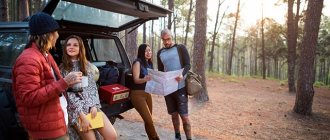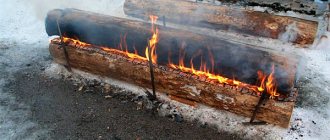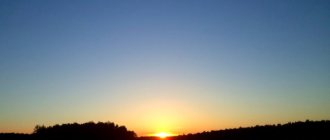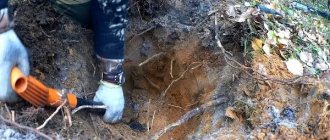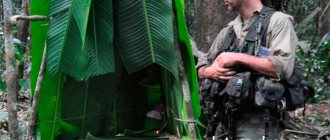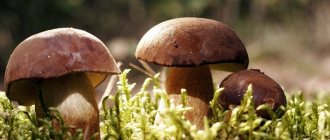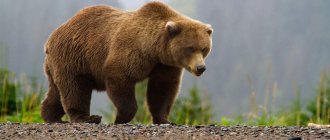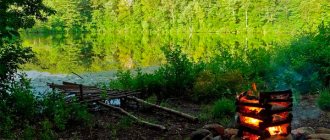Lighting a fire in the rain is often more important than in dry, warm and sunny weather, because it is in the rain that the need to warm up and dry things often arises.
It is in such conditions that in order to light a fire, a person will need special knowledge and skills, without which the chances of sitting by the fire will tend to zero. It is this knowledge that we will talk about next.
The man on duty at the campfire - it is clear that the fire has been burning for an hour, despite the heavy rain.
In order to make a fire in rainy weather, you should adhere to the following algorithm:
- Organize a canopy.
- Make flooring.
- Collect dry kindling, brushwood and firewood.
- Build a fire and light it.
Now let’s look at each of the points in more detail and look at a few more questions related to this topic.
We make a canopy from improvised materials
During heavy rain, you cannot do without a canopy. And even though a big hot fire can burn even in rainy weather, before the fire becomes such, it will go through the stage of a small fire, which will not be difficult to put out by the rain. Such a fire must be protected from water.
First of all, you should look for a natural shelter, which could be an overhanging rock, a cave entrance, a tree with a lush crown, and many other natural objects. There must be two main requirements for such a shelter: it must protect the fire well from precipitation and be safe for the person lighting the fire. For example, you cannot make a fire deep in a cave, so as not to suffocate from the smoke.
If it was not possible to find a natural shelter, then protection for the fire can be made from improvised means. Most often, tourists use special awnings for these purposes, but you can also stretch polyethylene over the site of the future fire.
The simplest canopy for a fire made of polyethylene.
In the second case, you need to ensure that the fire does not burn through the polyethylene, and for this, the distance from the fire to the canopy must be chosen with a margin of distance. It would be good if this distance can be adjusted, so that when the fire weakens, it can also be protected from the wind by lowering the canopy itself.
We make flooring
After prolonged rains, due to the abundance of puddles and mud, it is advisable to build a deck for the fire. Otherwise, the kindling and brushwood may get wet, and the fire itself will not burn as well as on the prepared flooring.
The flooring can be made from logs so that it does not burn out for a long time, although in some cases the use of brushwood and even tree bark is allowed. When it is possible to light a large fire, the flooring under it will burn out, but the ground will also partially dry out and will no longer pose a threat to the fire.
The photo shows an example of such flooring:
Kindling, brushwood and firewood
Kindling, brushwood and firewood for lighting a fire must be dry. If they are wet and damp, starting a fire will be extremely difficult, if not impossible.
In rainy weather, you can collect dry kindling and brushwood in the forest under natural canopies, for example, under large trees, on spruce trunks with lush spruce branches and under large boulders, which create protection from precipitation for the debris of natural origin lying underneath (dry grass, leaves and branches) . You can also dig up dry kindling from a forest anthill by removing the top layer. But you shouldn’t dig up the entire anthill: just take a piece of dry kindling and cover the resulting recess with the previously removed layer.
It is good as kindling and birch bark: thanks to its hydrophobic properties, it will burn even after rain.
The photo shows a tinder fungus taken from a tree - it also lights up perfectly with a match:
In principle, to ignite and fully burn many fires, you can get by only with kindling and brushwood. But if there is a need for dry firewood, then you can get it by dumping and splitting dead wood into logs: usually the middle of vertically standing dead trees remains dry even after prolonged rains, but you can also stumble upon rotten wood.
I talked in more detail about how and where to collect, store and use kindling, brushwood and firewood...
How to make a fire in the rain
The main thing you need to pay attention to when deciding how to make a fire in wet weather is the right choice of place. It is advisable to find an elevated and more or less dry area. But if this fails, then it is necessary to make a deck of stones or logs to isolate the fire from the wet ground.
In principle, you can build a fire even in a swamp. For example, like this: take 4 rogulins, stick them into the ground and build a platform on them for the future fire. The platform can also be made floating in the form of a raft, consisting of a couple of thick logs connected to each other with wire.
After the problem of moisture coming from below has been solved, care must be taken to protect the fire from moisture falling from above.
The most reliable thing in this case would be to make a canopy over the fire. The canopy can be made from a piece of plastic film or scrap materials. If there is nothing at all, then you need to cover the fire from the rain with your own body until it comes into force.
In wet weather, building a fire is the “taiga” type, when other logs are leaned against a log lying on a platform, forming the shape of a slope (by the way, in many sources, a “taiga” fire is called a “slope” or “roof”).
A pilot fire is lit under the roof of such a fire. You can use birch bark for kindling (it burns well even when wet). To do this, a piece of birch bark is rolled into a tube, and thin strips torn from another piece of birch bark are placed inside. The outer shell of such birch bark kindling will well protect the inside from rain until it flares up properly.
If you are unlucky and there is no easily obtained birch bark in the area, then you will have to get kindling from the middle of the dead wood. If it has been raining for a long time, then before cutting down a dead tree, pay attention to its top. If the top is missing, then most likely the tree inside is wet and rotten. Chop the one whose top is intact.
Having sawed suitable dead wood into logs, cut a thin splinter from the middle and “fluff” it, cutting the chips on one side. This will give you a high grade of kindling called a “fire stick.” If the weather is not very wet, then such an “incendiary” splinter can be made from broken dry twigs, rather than taking it out from the middle.
An important rule when starting a fire in the rain is that you need to handle the kindling and pilot light with dry hands. Dry them on your clothes or tuck them under your arms. Also make sure that water does not drip from your hair.
It is best to light a fire in the rain using three matches at once. Stack them like a ladder. Then, lighting up sequentially one after another, they will give a longer lasting heat.
You will make your task much easier if you have dry fuel, a piece of plexiglass or a candle in your survival kit. These items will help dry the kindling and light the fire faster.
Some useful tips:
— in the rain, firewood and kindling are harvested 2-3 times more than under normal conditions;
— you need to use gasoline or alcohol to start a fire by soaking it in a piece of cloth rolled into a rope, which you can then use as kindling. Do not throw flammable or explosive substances into the fire.
— when using flares, kindling is also ignited, not wet wood. If the flare lasts a long time (10 minutes), then you can also set fire to the firewood, but it is advisable to first trim it, trimming as many shavings as possible. The flare should be held along the logs so that the flame covers the largest surface;
— wet wood is dried while the fire is burning. To do this, they are laid side by side or placed with one side piled on the fire beam.
Lighting a fire
Many fires can burn in the rain and even on damp wood: the thermal energy released when a large fire burns is usually enough to heat and evaporate the water in the wood and falling on it in the form of precipitation. It all depends on the duration and intensity of the rain, the size and type of fire, and the moisture content of the fuel.
In order to light a fire, you need to provide, if not ideal, then close to ideal conditions in the form of a canopy, flooring and dry fuel. With well-honed skills, a fire can be made without any additional equipment at all, even without matches, but this requires high skill.
The video shows how to make a fire without matches in a damp forest:
At first it is better to light a fire, called a hut by tourists. It is this that will provide good air draft and high temperature necessary for fuel combustion. Once the hut is lit, it can be transformed into a “well” or “grid” fire, which will allow you to simultaneously dry brushwood and firewood before lighting it.
It would not be amiss to remind you that the fire should be lit by initially placing only the thinnest branches and wood chips in it. And only after it flares up, increase the thickness of the added fuel. In the case of lighting a fire in the rain, this rule is more relevant than ever.
It should be noted that some fires are not afraid of rain. Thus, a Dakota hearth, being covered with a container in which, for example, food is heated, will not go out from a short rain until water gets inside the pit. And even if water seeps through the soil, the heat inside this very hole will be enough to evaporate a certain amount of moisture.
The Finnish candle fire is even more resistant to rain. This type of fire, covered with utensils, will burn even in heavy rain. The video shows an example of such a fire:
Lighting a fire in wet weather
Coniferous trees will be the best helpers in wet weather. Pine and spruce branches contain a resinous substance - oleoresin, thanks to which they burn well even in the rain. Before use, you need to clean the branches from the bark that absorbs moisture. Please note that coniferous wood burns out quickly and leaves few coals, so it should be used for the initial ignition, and then add other types of wood. Before using firewood, you need to remove the bark to get to the dry core.
An exception may be birch. Birch bark is an excellent fire starter, producing plenty of heat to keep the fire going even on a rainy or windy day. In wet weather, try to find dry, but not fallen trees - they accumulate less moisture and the core is more likely not to be rotten and rotten.
Use logs and branches split lengthwise. They dry out and light up faster.
For the initial ignition, it is worth building a fire in the shape of a cone about 20 centimeters high, from small dry wood and other easily burning materials. This design flares up quickly and allows you to dry the branches located in the upper layers.
If there is a strong wind, you will not be able to start a fire this way. In this case, you need to build a shelter around the fire from stones, branches and earth (Figure 2).
Figure 2. Earth wind shelter for a fire
Lighting for a fire
Fire starters often refer to liquid or solid substances that help start a fire.
Such substances include, for example, industrial lighter fluids, sunflower oil, wax and paraffin candles, strips of rubber and pieces of plexiglass. Tourists often use ignition to start a fire in difficult weather conditions, including rain.
It is advisable to take care of purchasing the ignition in advance and always carry it with you. But if suddenly this was not done for some reason, ignition for a fire can also be found in the wild. For example, the resin of coniferous trees and the birch bark I mentioned earlier have long been used as such ignition. You can also use fat-rich nut kernels and various anthropogenic debris, for example, caps from PET bottles and pieces of rubber from tires, as ignition.
You can learn more about lighting a fire in a separate article...
It is important to note that without matches and a lighter, starting a fire in the rain is not an easy task, so you should take care of supplies of these ignition supplies in advance, carry them in sealed packages in your backpack and pockets, practice lighting a fire in different weather conditions, and also master methods of igniting fire by friction.
Author: Maxim Chechetov
How to light a fire in the forest correctly
An integral attribute of all hikes is a fire. You need to be able to light it in different conditions. It is important to know the following criteria:
- Selecting a place to make a fire.
- Principles of preparing the site and firewood.
- Kindling methods.
- Ways to start a fire in any weather and season.
Selection of location
The best place for a fire in the forest is one that is reliably protected from wind and precipitation. It is optimal if it has a natural shelter, for example a rock. If there is a source of water nearby, that’s generally great. The main thing is not to violate the PPB.
The fire must not burn:
- Under the treetops.
- Between massive roots.
- Among dry and young coniferous trees.
- In an area with dry grass.
- On stone placers.
- On the peat bogs.
An open area is selected for the fire. Its position relative to the tents is the leeward side. His distance from them: 3-5 m
Preparing the area
All leaves, dry grass, twigs and other debris are removed from the fire area. The top soil layer is eliminated. The site is surrounded by stones. In open steppe zones, the fire necessarily deepens. A defensive wall is erected on the side of the blowing wind.
In winter, snow is completely removed from the site until you see the ground. Another option is to make a shelf out of sheet metal or mesh. She is suspended by guy wires. You also need a modest fire pit. This way the snow will not extinguish the coals.
In winter or in bad weather, you should build a fire in a damp forest on a special flooring. It is formed by logs. At the same time, the coals at the first stage will not be extinguished by damp soil.
Question about fuel
Dry material from deciduous trees produces almost no smoke. And damp wood, or its rotten version, generates little heat but a lot of smoke. Material from living birch contains a lot of moisture. If there is a shortage of choice, chop it into logs.
Dry small brushwood produces a powerful fire. But this material quickly burns out. The dry pine version burns well. It produces a lot of coals, but also significant volumes of smoke and soot. There are still a lot of sparks flying around. This option is well suited for fire signals.
Material from oak or hornbeam produces excellent heat and small fire. The burning continues for about two hours. This is a good condition for cooking. This fire does not need to be very large. After all, you need to work with dishes and prepared dishes.
In areas where vegetation is scarce, dry peat and completely dry animal droppings are used as fuel.
On sea coasts and river banks, dried wood can be used as fuel
Kindling methods
How to dilute correctly, conveniently and quickly? Here we need materials that quickly ignite: dry grass, moss, birch bark, reeds, pine bark, small wood chips with resin.
In the rain it is better to use birch bark. It is almost always dry.
The kindling is folded into a pyramid. Set on fire. It won't hurt to take from home:
- dry alcohol capsules,
- candles,
- elements of rubber and plexiglass.
In the rain, a special liquid based on paraffins, for example Forester, will help kindling.
The use of gasoline is strictly prohibited. The wood will not light. And you will be poisoned.
Fire formation
The main thing in this matter is not to soak or damage the matches. They are dipped in paraffin up to 1/4 of the length. Placed in a sealed plastic or metal container.
If there are no matches and the weather is sunny, a magnifying glass or optical lenses will help. In some situations, the glass of the watch is removed. Water is poured in there. In winter, a straight lentil-shaped piece of ice is polished.
The tinder is ignited using sunlight. It is created from very small bark leaves with resins, cotton wool, fluff, etc.
You can get fire using the taiga method: rub the onion, drill and supporting components. The supports can be material from oak, birch or dry bamboo stems cut lengthwise. In fact, this method takes a lot of effort and time and is used extremely rarely. Of course, today you take a lighter on a hike.
Another reliable method is flint. For example, you can buy a version that has a magnesium rod. It creates a powerful spark.
Types of fire
This or that type of fire is used depending on the purposes and conditions.
So, its varieties and collection rules are as follows:
- Hut. Firewood forms a house or hut. Lighting position: bottom side between logs. This type is good for cooking and lighting. You need a serious supply of firewood. It's not difficult to burn without matches.
- Well. It has a log frame format. Short but thick logs or logs are used (for a serious fire). Inside there is small firewood, piled in a hut and a small pile.
- Fireplace. Great option for heating at night. Its burning continues almost until the morning. It is formed by four short logs, folded as in step 2. An inclined wall is made on one side: you need to drive two thick stakes in an inclined position. Massive logs are stacked on top of each other. The fire is organized inside the structure. According to the degree of burning of the lower elements (logs), the upper elements smoothly end up at the bottom.
- Nodya. Large logs are needed. Length - maximum 3 m, minimum diameter - 30 cm. Dry trunks of pine trees and other coniferous species are usually used. First, using an ax, sastrugi are made along the entire length of the logs. The chips are not completely removed. Then the logs are laid out in the longitudinal direction, one on top of the other. They are fixed on the sides with stakes. The number of stakes is 4. Their material is wet wood. They are driven into the ground. There is a version with three logs. It lacks a fence. The two elements have a parallel position to the ground. They are arranged right next to each other. The third element falls on them. Between them are wet pegs. This increases the air flow. Then kindling is placed there.
- Star. For any task, 5-10 massive elements are used to form it. These are logs or logs. Their length: 2-3 m. They are folded with the ends in a star format. According to the degree of combustion, the elements move towards the middle. If the fire is small, it produces a narrow and hot flame. This is an excellent condition for cooking. It is important not to leave the “star” unattended.
- Taiga view. On a log with a solid length at an acute angle and a slight overlap (no more than 50 cm), 3-4 other logs are placed. The main function of this type is heating.
- Polynesia. This is a pit. Its approximate depth is -1 m. It tapers like a cone. Massive elements are used to line its walls. A fire is made at the bottom. This species generates a lot of coals. This is the best option in rainy, cold and very windy weather.
Some recommendations
If it’s difficult to light a fire, they need to be sprinkled with a handful of salt.
Massive parts of birch bark, when they burn, are wound into a tube. This is how the fire is extinguished. For this reason, use small triangular pieces of birch bark for kindling. Bend them in half.
When there is a need to preserve and transfer the fire to a new area, place the coals in empty tin cans or in birch bark folded into a tube.

